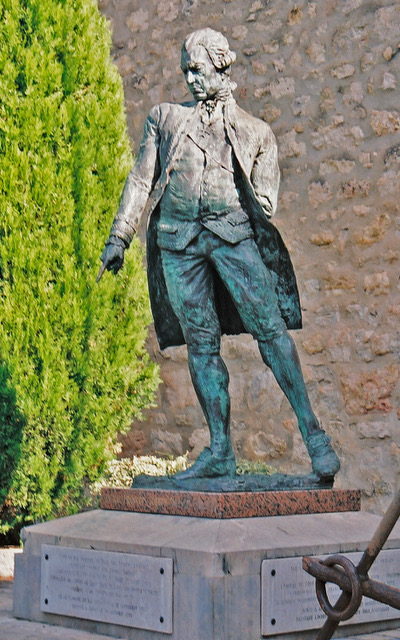The Franco-American Riviera
The Birth of America

On the Place de la Tour on a plateau in the village of Bar Sur Loup in the Alpes Maritimes, stands a large bronze statue of a man in 18th century naval uniform. He is pointing forcibly at the ground, rather as if he is demanding that someone clean up after their dog. In fact his attention is fixed on a large ship’s cannon, for this is the Amiral de Grasse, one of the French commanders responsible for defeating the British Navy during the American War of Independence.
François Joseph Paul, Comte de Grasse, son of the Marquis de Grasse, was born in 1722 and grew up in the imposing 13th century château behind where his statue stands. He became a galley boy (albeit an aristocratic one) in France’s naval involvement with the Mughal and Hindu Maratha Empires in India. And at the age of 17 he formally entered the French Navy where he would engage in its many battles across the world.
The Seven Years War, which pitched France and Spain against Britain but was virtually a global conflict, would keep him, intermittently, on the Indian continent for around 20 years. During this time he fathered an Indian child, who he would recognise and bring to France to be educated. He renamed him George de Grasse. George would eventually move to New York in 1799, where he married and became a respectable citizen. His own son, John van Salee de Grasse, was the first African American to graduate from medical school. John de Grasse served as a surgeon during the American Civil War.
The Seven Years War ended with the first Treaty of Paris which divided the spoils and from which Britain gained many of its future colonies. By 1763 it had taken control of much of North America, French Canada and colonies such as Barbados, the Bahamas and Jamaica in the Caribbean. Now, after defeat, de Grasse began the process of rebuilding the French Navy.
Fierce arguments over taxation between America and Britain were destined to lead to the American Revolutionary War. From 1775 the French, a long-term rival of Britain, began surreptitiously giving aid to America’s army. The Treaty of Alliance of 1778 between France and America, brought France firmly into the war against the British colonialists. A war which would last eight years.
Coming from a victory in the Battle of Fort Royal at Martinique in 1781, de Grasse sailed to North America. But not before he had extracted a load of silver pesos collected from the people of Havana to fund the expedition.
In September he engaged the British Fleet of Admiral Thomas Graves in a crucial battle. Commanding his fleet from his flagship, the Ville de Paris, de Grasse overcame the British at Chesapeake Bay in Virginia enabling the French to gain control of the sea lanes and preventing the evacuation of British Forces from Yorktown. The Siege of Yorktown effectively helped to secure a lasting independence for America.
A year later, in 1782 de Grasses’s fortunes changed when the British fleet roundly defeated the French at the Battle of Dominica in the Caribbean. Among the many prisoners taken was de Grasse himself, along with the Ville de Paris. After a short detention during which he was shown to King George III in London, he returned to France where he was strongly criticised for his part in the defeat. He swiftly demanded a court-martial to clear his name, which resulted in his acquittal and after which he retired to his charming Louis XIII Château de Tilly in the Ile-de-France, where he died in 1788, age 65.
In 1789 another revolution was getting underway and here the aristocratic de Grasse family would not be welcome. The people of France were rebelling against the aristocracy, the church and the status quo. De Grasse’s only son Auguste, a naval officer, was posted to Sainte Domingue, a French colony on what is now the island of Haiti, where his four sisters joined him and where the family had a large estate. They moved on once more when the British Navy defeated the French fleet during the Haitian Revolution, and settled for a time in Charleston, South Carolina, where two of the sisters died of yellow fever. The youngest, Sylvie, married Francis de Pau, a rich shipowner with whom she had seven children, all born in Charleston. The family then moved to New York, to a luxuriously furnished house at 358 Broadway.
There is a monument to the Amiral de Grasse and his sailors at the Cape Henry Memorial in Virginia. His statue is on the riverside walk in Yorktown. There is a Grasse Mount estate in Burlington, Vermont. The Grasse River flows through St. Lawrence County, New York. Two French Line passenger ships bore vessels in his name. Both the French and the United States Navies named ships after him. There is even a stamp.
In 1916, Corinne Roosevelt Robinson, the sister of President Theodore Roosevelt, wrote a poem to France defining the reasons for the enormous aid programme America was pouring into France during the First World War:
Ah, France, who gave us Lafayette
When we were scarred as you are now
Before your wounds we humbly bow
And bless you for our deeper debt!
© Copyright: Maureen Emerson 2021
